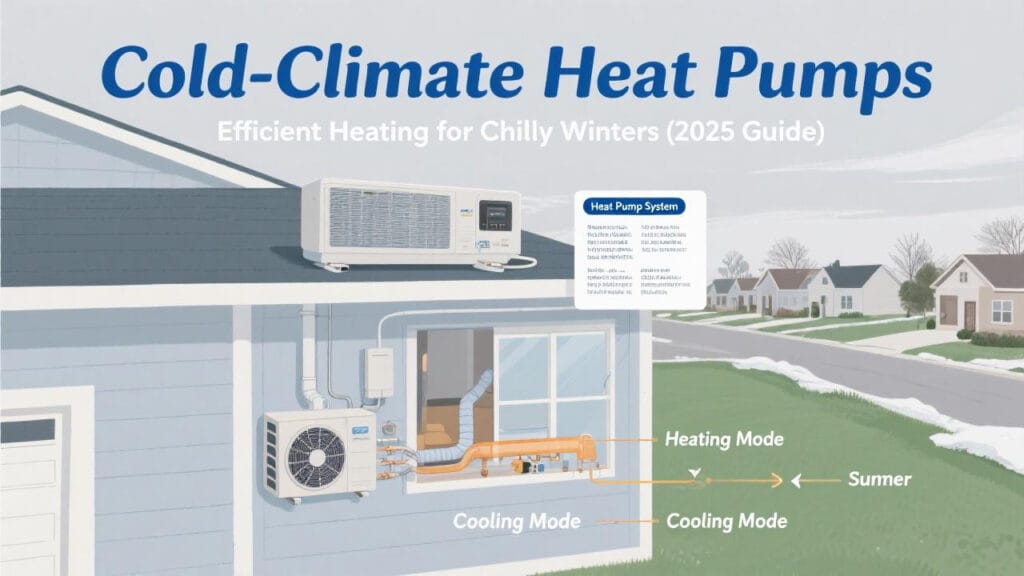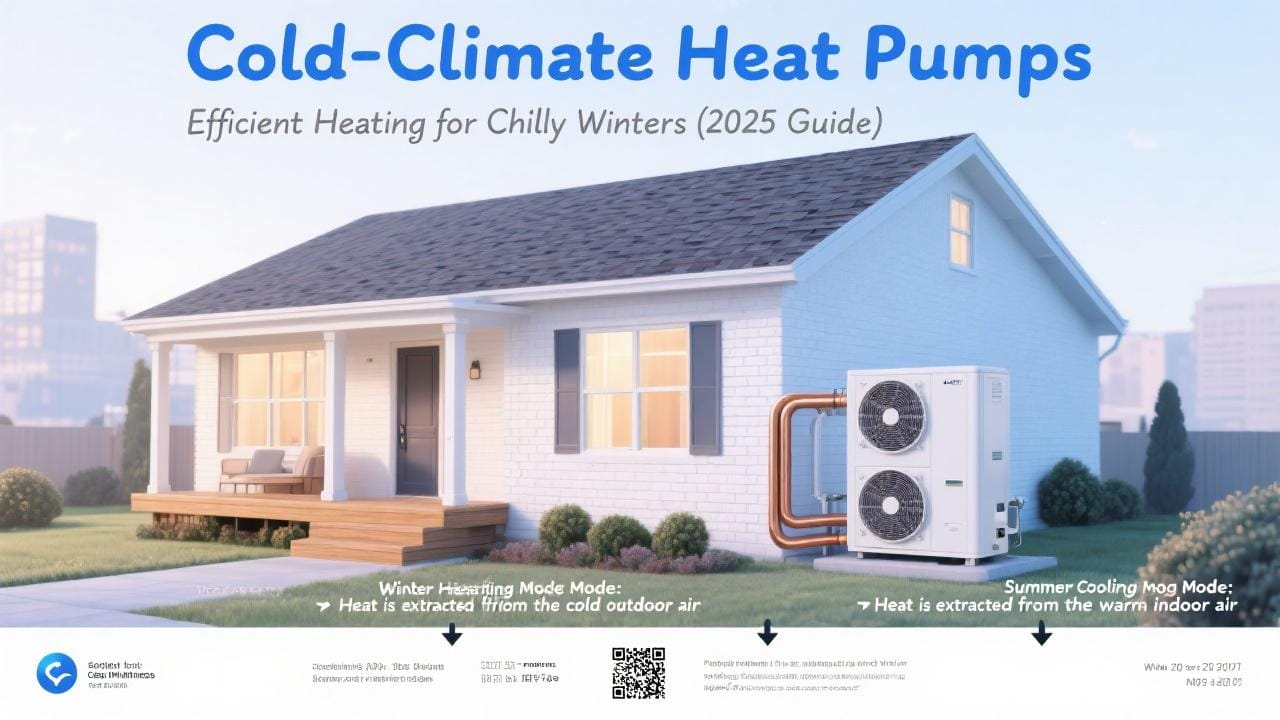Busting the Myth About Heat Pumps in Winter
For years, a common misconception plagued air-source heat pumps (ASHPs): “They don’t work well in cold weather.” While older models did struggle when temperatures plummeted, heat pump technology has advanced dramatically. In 2025, specialized cold-climate heat pumps (CCHPs) are engineered to provide efficient and reliable heating even in sub-zero Fahrenheit temperatures, making them a viable and increasingly popular choice for homeowners in chilly northern climates. This guide explores what makes CCHPs different and why they are a game-changer for energy-efficient heating in winter.
The Challenge of Traditional Heat Pumps in Cold Weather
Standard air-source heat pumps work by extracting heat from the outdoor air and transferring it inside. As outdoor temperatures drop, there’s less heat available in the air, and older heat pumps would become less efficient and struggle to meet the home’s heating demand. This often necessitated a less efficient backup heating system (like electric resistance strips or a fossil fuel furnace) to kick in, negating some of the heat pump’s energy savings.
What Makes Cold-Climate Heat Pumps Different?
Cold-climate heat pumps are specifically designed with advanced features to overcome these challenges and maintain high efficiency and heating capacity at much lower outdoor temperatures:
- Variable-Speed Compressors with Enhanced Vapor Injection (EVI):
- Variable Speed: Unlike single-stage compressors that are either on or off, variable-speed (or inverter-driven) compressors can adjust their output precisely to match the heating demand. This allows them to run more consistently at lower speeds, improving efficiency and comfort.
- Enhanced Vapor Injection (EVI): This is a key technology in CCHPs. EVI involves injecting a small amount of additional refrigerant vapor into the compression cycle at a specific point. This boosts the compressor’s capacity and efficiency at low ambient temperatures, allowing the heat pump to extract more heat from cold outdoor air and deliver hotter air indoors.
- Larger Coils and Fans:
- CCHPs often have larger outdoor coils (evaporators in heating mode) and more powerful fans. This increased surface area and airflow allow them to absorb more heat from the cold air more effectively.
- Improved Defrost Cycles:
- When operating in cold, humid conditions, frost can form on the outdoor coil, reducing its ability to absorb heat. CCHPs have more intelligent and efficient defrost cycles. They monitor frost buildup and initiate a brief reverse cycle to melt the frost only when necessary, minimizing energy consumption during defrost and ensuring quicker return to heating mode.
- Advanced Refrigerants:
- Modern heat pumps use refrigerants that are more effective at transferring heat, even at lower temperatures, and have lower global warming potential (GWP).
- Optimized System Controls:
- Sophisticated control algorithms optimize the performance of all components (compressor, fan, reversing valve, defrost) for cold-weather operation.
Thanks to these advancements, many CCHPs in 2025 can operate efficiently and provide substantial heating capacity at outdoor temperatures down to -13°F (-25°C) or even lower, with some models maintaining a high Coefficient of Performance (COP) even at 5°F (-15°C).

ENERGY STAR Cold Climate Certification: A Mark of Performance
To help consumers identify heat pumps specifically designed for colder regions, ENERGY STAR has a “Cold Climate” recognition as part of its “Most Efficient” criteria for 2025. To achieve this, heat pumps must meet specific performance metrics at low temperatures, including:
* A high Coefficient of Performance (COP) at 5°F (e.g., COP ≥ 1.75).
* A high percentage of heating capacity maintained at 5°F compared to its capacity at 47°F (e.g., ≥ 70% for some categories, though the 2025 criteria specify ≥45% for non-cold climate and have specific metrics for cold climate designated units).
Choosing an ENERGY STAR Cold Climate certified heat pump provides assurance that the unit is engineered for efficient performance in your chilly winters. These models are also prime candidates for federal tax credits (up to $2,000) and other local incentives.
Benefits of Installing a Cold-Climate Heat Pump in 2025:
- Significant Energy Savings: CCHPs can drastically reduce heating bills compared to electric resistance heat, heating oil, or propane furnaces, and can even be more cost-effective than natural gas furnaces in many situations, especially with rising fossil fuel prices.
- Year-Round Comfort: Provides efficient heating in winter and efficient air conditioning in summer with a single system.
- Reduced Carbon Footprint: By using electricity more efficiently and potentially displacing fossil fuel heating, CCHPs significantly lower your home’s greenhouse gas emissions.
- Elimination or Reduction of Backup Systems: In many cold climates, a properly sized CCHP can be the primary heating source, reducing or eliminating the need for a less efficient backup system.
- Improved Indoor Air Quality: Compared to combustion heating, heat pumps don’t produce any on-site emissions.
Considerations for Cold Climates:
- Proper Sizing is Crucial: Even more so than in milder climates, accurate sizing based on a Manual J load calculation is essential to ensure the CCHP can meet your home’s heating demand on the coldest days.
- Home Weatherization: To get the best performance from any heating system, ensure your home is well-insulated and air-sealed. A home energy audit can identify areas for improvement.
- Installer Expertise: Choose an HVAC contractor experienced in installing and servicing cold-climate heat pumps in your region. They will understand local conditions and proper installation techniques.
- Ductless Mini-Split Options: Cold-climate ductless mini-split heat pumps are also widely available and are excellent for homes without ductwork or for providing zoned heating in specific areas.
Efficient Warmth, Even When It’s Freezing
The notion that heat pumps aren’t suitable for cold climates is outdated. Modern cold-climate heat pumps available in 2025 are a testament to technological advancement, offering remarkable efficiency and reliable heating performance even when winter does its worst. With features like variable-speed compressors with EVI, larger coils, and smart defrost controls, CCHPs provide a compelling, energy-saving alternative to traditional heating systems in colder regions.
By selecting an ENERGY STAR Cold Climate certified model and ensuring proper sizing and installation by a qualified professional, homeowners in chilly regions can enjoy the significant benefits of heat pump technology year-round. When exploring your options, consider seeking installers who are knowledgeable about the latest CCHP technology and available incentives, similar to how EnergySage connects homeowners with vetted solar experts.



